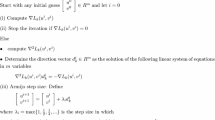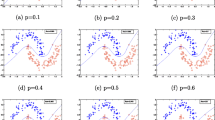Abstract
Classical support vector machine (SVM) and its twin variant twin support vector machine (TWSVM) utilize the Hinge loss that shows linear behaviour, whereas the least squares version of SVM (LSSVM) and twin least squares support vector machine (LSTSVM) uses L2-norm of error which shows quadratic growth. The robust Huber loss function is considered as the generalization of Hinge loss and L2-norm loss that behaves like the quadratic L2-norm loss for closer error points and the linear Hinge loss after a specified distance. Three functional iterative approaches based on generalized Huber loss function are proposed in this paper to solve support vector classification problems of which one is based on SVM, i.e. generalized Huber support vector machine and the other two are in the spirit of TWSVM, namely generalized Huber twin support vector machine and regularization on generalized Huber twin support vector machine. The proposed approaches iteratively find the solutions and eliminate the requirements to solve any quadratic programming problem (QPP) as for SVM and TWSVM. The main advantages of the proposed approach are: firstly, utilize the robust Huber loss function for better generalization and for lesser sensitivity towards noise and outliers as compared to quadratic loss; secondly, it uses functional iterative scheme to find the solution that eliminates the need to solving QPP and also makes the proposed approaches faster. The efficacy of the proposed approach is established by performing numerical experiments on several real-world datasets and comparing the result with related methods, viz. SVM, TWSVM, LSSVM and LSTSVM. The classification results are convincing.








Similar content being viewed by others
References
Balasundaram S, Gupta D, Prasad SC (2017) A new approach for training Lagrangian twin support vector machine via unconstrained convex minimization. Appl Intell 46(1):124–134
Batista M (2009) A note on a generalization of Sherman–Morrison–Woodbury formula. arXiv:0807.3860
Borah P, Gupta D, Prasad M (2018) Improved 2-norm based fuzzy least squares twin support vector machine. In: 2018 IEEE symposium series on computational intelligence (SSCI), pp 412–419
Borah P, Gupta D (2019) A two-norm squared fuzzy-based least squares twin parametric-margin support vector machine. In: Machine intelligence and signal analysis, Springer, Singapore, pp 119–134
Cortes C, Vapnik V (1995) Support-vector networks. Mach Learn 20(3):273–297
Demšar J (2006) Statistical comparisons of classifiers over multiple data sets. J Mach Learn Res 7:1–30
Ding S, Han Y, Yu J, Gu Y (2013) A fast fuzzy support vector machine based on information granulation. Neural Comput Appl 23(1):139–144
Ding S, Wu F, Shi Z (2014) Wavelet twin support vector machine. Neural Comput Appl 25(6):1241–1247
Ding S, An Y, Zhang X, Wu F, Xue Y (2017) Wavelet twin support vector machines based on glowworm swarm optimization. Neurocomputing 225:157–163
Ekong U, Lam HK, Xiao B, Ouyang G, Liu H, Chan KY, Ling SH (2016) Classification of epilepsy seizure phase using interval type-2 fuzzy support vector machines. Neurocomputing 199:66–76
Fung G, Mangasarian OL (2001) Proximal support vector machine classifiers, Proceedings of the international conference on knowledge discovery and data mining, San Francisco, CA, pp 77–86
Garg A, Shankhwar K, Jiang D, Vijayaraghavan V, Panda BN, Panda SS (2018) An evolutionary framework in modelling of multi-output characteristics of the bone drilling process. Neural Comput Appl 29(11):1233–1241
Guo J, Yi P, Wang R, Ye Q, Zhao C (2014) Feature selection for least squares projection twin support vector machine. Neurocomputing 144:174–183
Gupta D, Borah P, Prasad M (2017) A fuzzy based Lagrangian twin parametric-margin support vector machine (FLTPMSVM). In: 2017 IEEE symposium series on computational intelligence (SSCI), pp 1–7
Gupta D, Richhariya B (2018) Entropy based fuzzy least squares twin support vector machine for class imbalance learning. Appl Intell 48:1–20
Gupta D, Richhariya B, Borah P (2018) A fuzzy twin support vector machine based on information entropy for class imbalance learning. Neural Comput Appl. https://doi.org/10.1007/s00521-018-3551-9
Huang H, Wei X, Zhou Y (2018) Twin support vector machines: a survey. Neurocomputing 300:34–43
Khemchandani R, Chandra S (2007) Twin support vector machines for pattern classification. IEEE Trans Pattern Anal machine Intell 29(5):905–910
Kumar MA, Gopal M (2009) Least squares twin support vector machines for pattern classification. Expert Syst Appl 36(4):7535–7543
Li H, Misra S, He J (2019) Neural network modeling of in situ fluid-filled pore size distributions in subsurface shale reservoirs under data constraints. Neural Comput Appl. https://doi.org/10.1007/s00521-019-04124-w
Mangasarian OL, Wild EW (2001) Proximal support vector machine classifiers. In: Proceedings KDD-2001: knowledge discovery and data mining
Murphy PM, Aha DW (1992) UCI repository of machine learning databases. Department of Information and Computer Science, University of California, Irvine, CA
Peng X (2011) TPMSVM: a novel twin parametric-margin support vector machine for pattern recognition. Pattern Recognit 44(10–11):2678–2692
Qi Z, Tian Y, Shi Y (2012) Laplacian twin support vector machine for semi-supervised classification. Neural Netw 35:46–53
Ripley BD (2007) Pattern recognition and neural networks. Cambridge University Press, Cambridge
Rozza A, Manzo M, Petrosino A (2014) A novel graph-based fisher kernel method for semi-supervised learning. In: IEEE 22nd International conference on pattern recognition (ICPR), pp 3786–3791
Samui P, Kim D (2013) Least square support vector machine and multivariate adaptive regression spline for modeling lateral load capacity of piles. Neural Comput Appl 23(3–4):1123–1127
Shafiabady N, Lee LH, Rajkumar R, Kallimani VP, Akram NA, Isa D (2016) Using unsupervised clustering approach to train the support vector machine for text classification. Neurocomputing 211:4–10
Shao YH, Zhang CH, Wang XB, Deng NY (2011) Improvements on twin support vector machines. IEEE Trans Neural Netw 22(6):962–968
Singh D, Khan MA, Bansal A, Bansal N (2015) An application of SVM in character recognition with chain code. In: IEEE Communication, control and intelligent systems (CCIS), pp 167–171
Suykens JA, Vandewalle J (1999) Least squares support vector machine classifiers. Neural Process Lett 9(3):293–300
Tong Z, Deng X, Chen H, Mei J, Liu H (2019) QL-HEFT: a novel machine learning scheduling scheme base on cloud computing environment. Neural Comput Appl. https://doi.org/10.1007/s00521-019-04118-8
Vijayaraghavan V, Garg A, Gao L, Vijayaraghavan R, Lu G (2016) A finite element based data analytics approach for modeling turning process of Inconel 718 alloys. J Clean Prod 137:1619–1627
Xu Q, Zhou H, Wang Y, Huang J (2009) Fuzzy support vector machine for classification of EEG signals using wavelet-based features. Med Eng Phys 31(7):858–865
Zhai S, Jiang T (2015) A new sense-through-foliage target recognition method based on hybrid differential evolution and self-adaptive particle swarm optimization-based support vector machine. Neurocomputing 149:573–584
Zhang X, Chen W, Wang B, Chen X (2015) Intelligent fault diagnosis of rotating machinery using support vector machine with ant colony algorithm for synchronous feature selection and parameter optimization. Neurocomputing 167:260–279
Author information
Authors and Affiliations
Corresponding author
Additional information
Publisher's Note
Springer Nature remains neutral with regard to jurisdictional claims in published maps and institutional affiliations.
Rights and permissions
About this article
Cite this article
Borah, P., Gupta, D. Functional iterative approaches for solving support vector classification problems based on generalized Huber loss. Neural Comput & Applic 32, 9245–9265 (2020). https://doi.org/10.1007/s00521-019-04436-x
Received:
Accepted:
Published:
Issue Date:
DOI: https://doi.org/10.1007/s00521-019-04436-x




